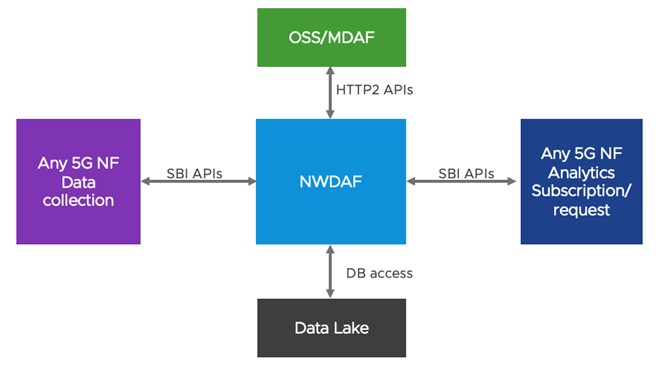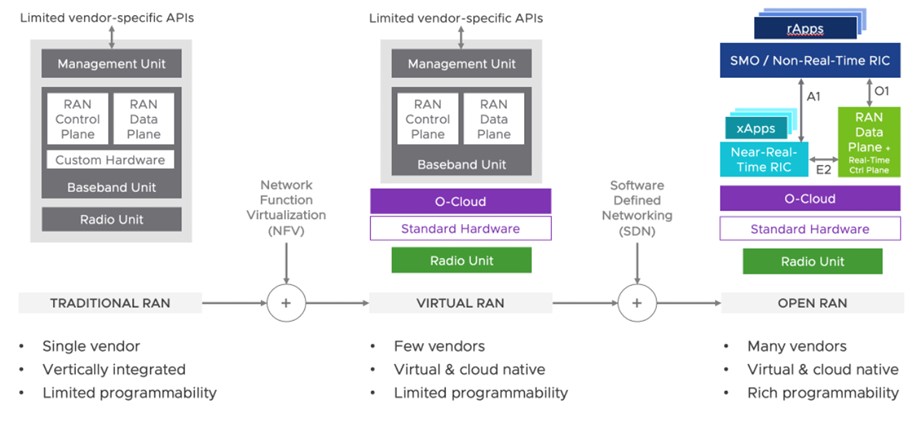Communication Service Providers (CSPs) are looking to unleash a new generation of dynamic edge applications. By combining the benefits of cellular connectivity with Multi-access Edge Computing (MEC), they can help enterprises tap into a new class of low-latency, high-bandwidth applications in areas like intelligent video analytics, Industry 4.0, Extended Reality (XR), and more. It’s an ambitious vision that Network-as-a-Service (NaaS) can help deliver.
NaaS must allow CSPs to offer network resources on demand, just like Software-as-a-Service (SaaS) today. It should provide advanced connectivity at a lower cost, with less time and effort, and be as “plug-and-play” as possible for customers. It must abstract away the complexities of the underlying infrastructure—even as that infrastructure grows more dynamic and involves more vendors.
To do this at scale, NaaS offerings will need use closed-loop automation—not just to enable zero-touch provisioning (ZTP) and deployment, but to respond changing conditions autonomously, without needing human intervention. Network orchestration and AI technologies have progressed to the point that such end-to-end automation is now within reach. However, one big gap remains: analytics.
By definition, closed-loop automation implies network orchestrators continually collecting real-time analytics from the network to track performance and assure services. But in today’s complex multivendor networks, there is no consistent standard or structure to the data that different infrastructure components generate. It varies from device to device. Before we can unleash the potential of NaaS, our industry needs to create a more consistent, standardized approach to analytics. The good news: that effort has begun.
AI-driven Automation Unlocks NaaS Possibilities
Why is closed-loop automation a prerequisite for NaaS? Because modern networks are enormously complicated. As both underlay and overlay network technologies grow more dynamic and disaggregated, complexity grows exponentially. There is no way for human beings to monitor and debug networks without automated, AI-driven tools.
Modern networks employ hierarchical orchestration, with service- and domain-level orchestrators using analytics-driven AI components to provide some level of closed-loop operations. As these capabilities mature, CSPs will be able to automatically deploy and configure complex multi-technology solutions incorporating network underlays (IP, LTE, or 5G) and overlays (such as SD-WAN or SASE). Network orchestrators will continually monitor those infrastructures to assure compliance with Service-Level Agreements (SLAs), using AI and analytics.
Ultimately, CSPs will be able to offer on-demand networks that can perform their own resource allocation and configurations automatically. And since such solutions require less manual intervention, CSPs will be able to scale faster, committing to more aggressive and profitable SLAs. Of course, this all depends on network orchestrators having consistent quantitative data to understand performance across end-to-end multi-vendor, multitenant networks. And today, they don’t.
Standardizing Analytics
The lack of consistent analytics across multi-vendor/multi-cloud networks creates persistent inefficiencies for CSPs. For example, operators often have to use separate tools to manage components from different vendors, increasing operational complexity and costs. When each vendor handles analytics in its own proprietary way, CSPs also become dependent on their vendors to facilitate automation—slowing innovation.
Standards bodies across the industry are working to tackle these issues and provide a new approach. Current efforts include:
- Network Data Analytics Function (NWDAF): First defined in 3GPP Release 15, NWDAF provides an analytics function for 5G Core (5GC) networks. NWDAF was originally designed to provide data collection and analytics services for 5GC network functions and OSS using service-based interfaces (SBI) and HTTP2 APIs. Releases 16 and 17 added new use cases and data collection APIs, spurring interest in using NWDAF for modular, scalable analytics in large networks.
- Management Data Analytics Function (MDAF): MDAF, also defined with 3GPP Release 15, provides a kind of network analytics clearinghouse, centrally collecting data from across the network and then publishing it to other network management and orchestration modules. It provides the Management Data Analytics Service for all network slice instances, sub-instances, and network functions hosted within a network infrastructure.
- RAN Intelligent Controller (RIC): Defined through the O-RAN Alliance, the RIC adds a platform to run diverse software applications in the RAN that enable programmable control and optimization. The RIC enables near real-time, granular user- and service-level control for closed-loop operations and automated SLA management. RIC architectures include two major components:
- Non-RT RIC: a management plane entity hosting applications (rApps) with control loops typically greater than 1 second
- Near-RT RIC: a control plane entity hosting applications (xApps) with control loops less than one second, typically on the order of tens of milliseconds
- Service Management and Orchestration (SMO): SMO, as defined by the O-RAN Alliance, provides a management and orchestration framework for the RAN domain. Key functions of the SMO include orchestration, workflow management, and cloud infrastructure management; network management (or “FCAPS”); and the Non-RT RIC. The SMO uses logic running in the Non-RT RIC to support use cases such as AI/ML training and modelling, policy, and cloud automation.
Today, the O-RAN Alliance and others are engaged in ongoing discussions to decompose the SMO and enable components from multiple vendors to collaborate in closed-loop operations.

Figure 3. RIC and SMO Framework
A Better Way to Automate
The 3GPP network functions for analytics and automation, combined with ongoing developments in O-RAN and SMO, show significant promise in enabling standards-based, repeatable, closed-loop automation. The potential for automated mass-scale NaaS solutions, driven by SLAs and real-time measurement of user experience, seems increasingly viable.
Today, vendors and CSPs are exploring early analytics-driven automation use cases that draw on RIC and SMO components to enable:
- User- and application-level optimizations such as having the RAN select the best network and radio band for each device, based on real-time conditions
- Network control enhancements, such as dynamic scaling and radio control based on network load predictions
- Monetization opportunities, such as device security as-a-service offerings based on anomaly detection intelligence and dynamic device profiling
By combining RAN, core, and operations and management data generated by the new 3GPP components, O-RAN components, and SMO, we can capture a comprehensive picture of the network. Just as important, applying AI/ML-powered analytics to this rich data set can provide the necessary intelligence to support a range of automation use cases. These approaches may need additional refinement before they can be deployed at scale. Nevertheless, early returns look promising, and this work is already demonstrating that analytics- and AI-driven automation can deliver significant ROI benefits with repeatability and scalability.
Looking Ahead
Using AI and standardized analytics will unlock limitless possibilities. Operators can dramatically simplify management and operation of their complex, large-scale networks. Analytics-driven automation will play a central role in helping CSPs transition away from providing basic connectivity to becoming full Digital Service Providers (DSPs) and partners to their enterprise customers. In the future, NaaS could empower CSPs to link smaller regional service providers, Mobile Virtual Network Operators (MVNOs) and more into unified “Network of Networks” solutions.
At VMware, we’re playing a key role in this industry evolution. We offer some of the most innovative telecom network and automation technologies, including:
- VMware Telco Cloud Platform, our multi-cloud horizontal platform that powers many of the world’s leading 4G and 5G networks
- VMware Telco Cloud Automation, which provides standards-based analytics and end-to-end orchestration of telecom networks
- VMware RIC (RAN Intelligent Controller), which makes RAN networks programmable by disaggregating control and management functions from the underlying data plane
- VMware Telco Cloud Service Assurance, which uses ML intelligence to enable a more automated, profitable RAN
Together, we are helping our customers develop more intelligent and automated telco networks based on standards, allowing them to transform and innovate faster.
Discover more from VMware Telco Cloud Blog
Subscribe to get the latest posts sent to your email.











